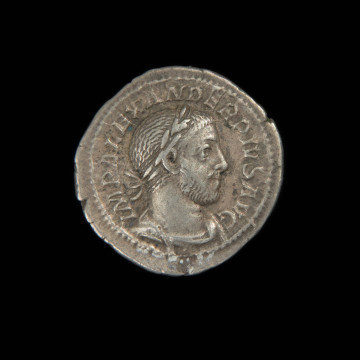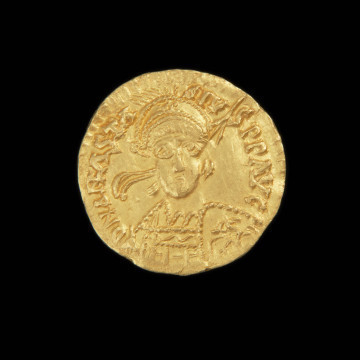
Denarius
231 — 235
National Museum in Szczecin
Part of the collection: Antique coins
Roman minting during the imperial period was decentralised and conducted in a dozen or so cities of the vast Empire. The rulers reserved the issuing of money from precious metals, while the minting of bronze coinage was left to the Senate and the cities. Aurei usually bear the image of the Emperor and personifications of virtues or ideas. Portraits of rulers are surrounded by royal titles, which include, in addition to the name and title, often the number of years of tribal power (TR P), as well as the consulships held by him (COS). These elements are essential for establishing the time of coinage. The presented aureus fits into the canon of imagery and legends used in this period to allow dating. Between 161 and 169, Marcus Aurelius ruled the Empire jointly with his adoptive brother Lucius Verus. Despite official equality, Verus had an inferior position. Lucius Verus and the goddess Salus are depicted on the coin. The Emperor's portrait is characterised by incredible realism and artistic value, comparable to his statues of that time. The goddess Salus as a patron of health and salvation, was depicted with attributes: a sceptre, a patera, and a snake, which symbolised self-renewal of life and healing due to its moulting. The cult of Salus took on particular significance during the reign of Marcus Aurelius (161-180). The source of the problems was a plague (smallpox, typhus) brought from the Middle East campaign that decimated the Romans. A recurrence of the epidemic might have caused Lucius Verus's death in 169. On the presented aureus, Salus is surrounded by the inscription SALVTI AVGVSTOR TR P III/ COS II (‘to the health of Augustus in his third year as tribune of the people / during his second consulship’). The presented aureus is unique, and it is the only such specimen found in Poland (Przelewice, the Pyrzyce district). The hole punched above the Emperor's head is a testimony to the adoption of gold coinage by barbarian peoples, and the Emperor's portrait must have played a vital role, presumably as a symbol of belonging to the local elite.
Genowefa Horoszko
Other names
Aureus
Author / creator
Dimensions
cały obiekt: height: 2,9 mm, diameter: 19,4 mm
Object type
coin
Technique
minting
Material
gold
Creation time / dating
Creation / finding place
Owner
National Museum in Szczecin
Identification number
Location / status

231 — 235
National Museum in Szczecin

247 — 249
National Museum in Szczecin

471 — 526
National Museum in Szczecin
DISCOVER this TOPIC
National Museum in Lublin
DISCOVER this PATH
Educational path